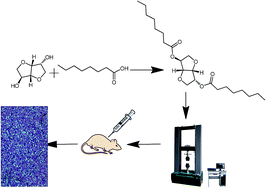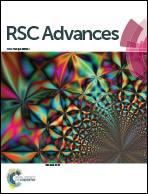Synthesis of biosafe isosorbide dicaprylate ester plasticizer by lipase in a solvent-free system and its sub-chronic toxicity in mice
Abstract
In this study, biosafe isosorbide dicaprylate ester based plasticizer was prepared using renewable feedstock with lipase in a solvent-free system. Different kinds of water removal methods and some important factors including molar ratio of the substrates, reaction temperature and catalyst loading were investigated. Bubbling dried air was determined to be the most effective water removal method. The activation energy (E) of hydrolysis and esterification to form di-substituted isosorbide were examined to determine the limiting step in the synthesis of isosorbide dicaprylate ester. The Ehydrolysis (25.51 kJ mol−1) was found to be higher than Esynthesis (35.65 kJ mol−1), demonstrating that the formation of diester from monoester is the critical step in the process. The lipase can be recycled up to 16 times while 80% diester was maintained. Additionally, the properties of poly(vinyl chloride) PVC blends plasticized with isosorbide ester as secondary plasticizer was studied. The results indicated that the thermal stability of plasticized PVC blends was improved, and the tensile strength was increased. Furthermore, the sub-chronic toxicity study in mice showed that the isosorbide ester was safe, indicating its great potential in industrial applications as a plasticizer.


 Please wait while we load your content...
Please wait while we load your content...